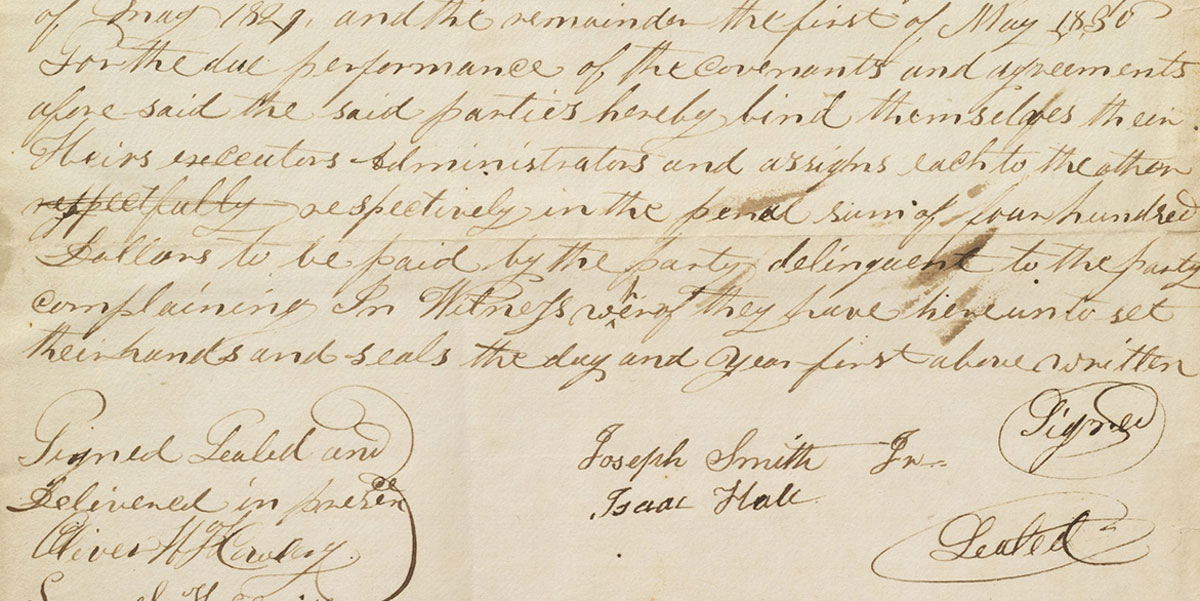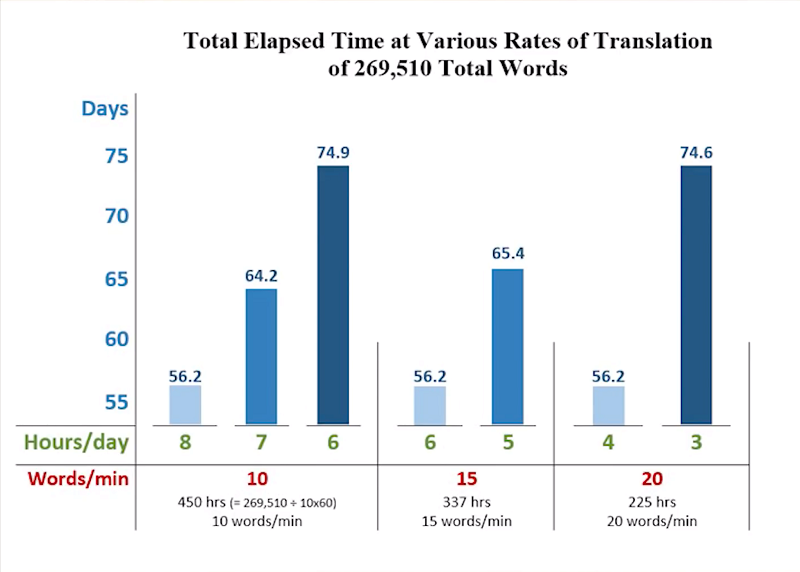
The Know
The Book of Mormon presents itself to the world as a miracle and as a sign that God has begun the process of gathering scattered Israel, as He anciently covenanted to do (see 3 Nephi 21:1–4; 29:1). For this and other reasons, many people have naturally been interested in the details of its coming forth, including the timing of its translation.
Various historical sources combine to prove that the English text of the Book of Mormon (as it was published in 1830) was essentially translated between April 7 and June 30, 1829. Fortunately, ongoing research has expanded and refined our understanding of many things that happened during and around these crucial three months. Drawing upon this research, the following summaries demonstrate why people can be confident that the vast majority of the Book of Mormon was translated within that narrow window of time.
Anchor Dates
Compelling data confirm the dates of five key events during the translation timeline. Regarding the first, Oliver Cowdery stated that he first arrived in Harmony, Pennsylvania, in the evening of April 5, 1829, that he helped Joseph with “some business of a temporal nature” on April 6, and that on the very next day, April 7, he “commenced to write the Book of Mormon,”1 as Joseph’s scribe.
Remarkably, a legal document discovered not long ago at a county courthouse near Harmony, Pennsylvania, bears Oliver’s handwriting and signature. It demonstrates that he served as a witness to an agreement dated April 6, 1829, between Joseph Smith and his father-in-law, Isaac Hale. On that day, Joseph purchased property from Hale on which stood the log cabin that Joseph and his wife Emma were living in.2 Oliver’s signature confirms that he was indeed with Joseph in Harmony on April 6, 1829, and now we know the nature of that notable “temporal” matter that he helped Joseph with on that precise day.
Such accuracy strongly invites and builds trust that Oliver was also correct about beginning his work as a scribe the very next day (April 7). He and Joseph worked in what we now know was Joseph’s newly purchased home—a place where they could hopefully work without disruptions. Four other dates, including the day by which the translation was surely completed (June 30), are each supported by other similarly credible documentation. Together, these five dates have been referred to as “anchor dates” because they help anchor reported details to specific days within the proposed translation timeline:3
|
Anchor Dates (1829) |
Associated Events |
|
April 7 |
Oliver Cowdery began working as Joseph’s scribe. |
|
May 15 |
John restored authority to baptize per 3 Nephi 11. |
|
May 31 |
The title page was completed. |
|
June 11 |
The Book of Mormon’s copyright was filed. |
|
June 30 |
The translation was completed. |
Time Needed to Receive and Deliver Additional Revelations
Thirteen revelations, each included in the Doctrine and Covenants, as well as a document called the “Articles of the Church of Christ,” were written during the time when the Book of Mormon was being translated. Not only do some of the words in those revelations correspond to details in historical reports of certain events during April, May, and June 1829, but in several cases they reflect words or ideas found in the Book of Mormon translation itself. This suggests that as the content of the Book of Mormon was received, further revelations and inspiration may have built upon what had just been revealed in its pages.
While any proposed relationships between these revelations and the Book of Mormon remain tentative, interesting analyses help locate which portions of the Book of Mormon may have been produced at particular points during the translation timeline. Whatever their relationship to passages in the Book of Mormon, receiving, delivering, and recording these additional revelations surely added another layer of time and distraction away from the already onerous and urgent translation.4
|
Date (1829) |
Possible Chapters Translated |
Associated Revelations/Documents |
|
April 6 |
|
About this time, D&C 6 was received, directed to Oliver Cowdery, as he began serving as Joseph Smith’s scribe. |
|
April 9
|
About this time, D&C 8 was received, directed to Oliver, about the power to translate. Compare Mosiah 8:11–16, speaking of King Mosiah’s power to translate. |
|
|
April 26 |
About this time, D&C 9 was received (compare D&C 9:14, “a hair of your head shall not be lost, and you shall be lifted up at the last day,” with Alma 11:44; 40:23). |
|
|
May 21 |
3 Nephi 28–30 and 4 Nephi |
About this time, D&C 7 may have been received, speaking about John not tasting death. Compare material in the account about the Three Nephites in 3 Nephi 28:1 (“what desirest thou?” D&C 7:1); 28:2 (“speedily,” D&C 7:4); 28:7 (“never taste death,” “power over death” in D&C 7:2) |
|
May 30 |
About at this point, D&C 12 was received, directed to Joseph Knight Sr. (compare D&C 12:8, “full of love,” “faith, hope and charity,” with Moroni 7:1; 8:14). |
|
|
May 31 |
About this time, D&C 11 was revealed, directed to Hyrum. Compare D&C 11:16 (“my gospel”), and D&C 11:25 (“deny not”) with Moroni 10:8, and the previously translated 3 Nephi 27:21. |
|
|
June 4 |
|
Traveled to Fayette and unpacked. About this time, D&C 10 was finalized, telling Joseph to translate the plates of Nephi (D&C 10:41). |
|
June 7 |
About this time, John and Peter Whitmer Sr. were baptized, and D&C 15 and 16 were received. |
|
|
June 8 |
About this time, D&C 14 was given for David Whitmer. |
|
|
June 9 |
About this time, D&C 18 was received (compare D&C 18:20, “church of the devil” with 1 Nephi 14:10). |
|
|
June 21 |
|
About this time, Oliver Cowdery composed the “Articles of the Church of Christ.” This document quotes extensively, verbatim, from the Original Manuscript of 3 Nephi 9:15–16, 18; 11:23–27, 32, 39–40; 18:22, 28–33; 27:8–10, 20; Moroni 3:1–4; 4:1–2; 5:1–2; 6:6; and also from D&C 18:4, 22–25, 31, 34. |
|
June 22 |
About this time, D&C 17 was received, authorizing Oliver, David, and Martin to obtain a view of the plates (D&C 17:2; compare 2 Nephi 27:12). |
Time Needed to Attend to Practical Tasks and Needs
In addition, several practical matters arose during the time of the translation that required time and attention, as has been independently confirmed by documentary evidence. For instance, Joseph once commented upon his poverty during the period of translation and that he petitioned the Lord for help.5 Joseph mentioned that shortly after his brother Samuel arrived (sometime in May),6 a Mr. Joseph Knight “several times brought us supplies (a distance of at least thirty miles) which enabled us to continue the work” of translation.7
Knight’s own account perfectly agrees with this situation. He repeatedly commented upon Joseph’s poverty, mentioned his multiple visits to supply Joseph and Oliver with necessary provisions, and even mentioned that Samuel Smith was present at the home.8 Historian Richard Lloyd Anderson described Knight’s recollection as “a talkative account that displays little awareness of what the Prophet had independently said.”9
In about twenty cases, details such as these help flesh out the proposed timeline.10 They also help confirm that the translators were accurate and truthful in their description of events and circumstances surrounding the translation.11
Estimating the Timing of the Translation
When combined together, the established anchor dates, revelations, and other supporting historical details give a nuanced and consistent view of the timing of the translation. On its face, the timeframe between April 7 and June 30 allows 85 possible days for the translation, but we know that on many of these days the translators were also engaged in other activities: doing farm chores, entertaining visitors, making trips to Colesville, receiving priesthood authority and additional revelations, baptizing Samuel and Hyrum Smith, moving from Harmony to Fayette, acquiring the Book of Mormon’s copyright, and so forth.12
Book of Mormon scholar John W. Welch has suggested that with these known disruptions and time constraints accounted for, “not many more than the equivalent of about 60 actual working days would have been available in April, May, and June 1829.”13 Terryl Givens described this rate of translation as “truly prodigious,”14 and Welch concluded that by “any standard” the pace was “blistering.”15
Translation Experiments
Some may wonder if translating the entire Book of Mormon in so short a time was even humanly possible. In order to answer this question, Welch calculated how quickly the translators would have needed to work in order to accomplish their task in the allotted time. Welch explained, “Several of the resulting hours-per-day and words-per-minute options yield elapsed time figures that fall within the realm of feasibility, but the latitude is not wide. The parameters here do not allow much variation beyond the values shown on this graph.”16
In order to test these estimated possibilities, Welch and his wife Jeannie informally replicated the process of translation as described by the witnesses, with one of them dictating the text and the other acting as scribe. They then recorded how many words they were able to produce per minute on average. They found the experience to be so insightful that they then tested out the process in their stake scripture class.17
Their combined results, while not strictly scientific, suggest “that a translation rate of right around 20 words per minute was quite possible.”18 Yet those who participated also felt that they couldn’t have sustained that pace very long without time for breaks. They reported, “Our hands got tired, and the one playing Joseph needed to catch his or her breath and clear his or her voice.”19 Moreover, they were using ballpoint pens, whereas Oliver Cowdery would have often needed some time to dip his quill pen and refill it with ink.20 Thus, while it is difficult to determine exactly how quickly on average the translation was carried out, it reasonably fell within the needed estimated range (10–20 words per minute) in order for the entire project to have been completed between April 7 and June 30.
The Why
This recent data and analysis demonstrate “that the historical documents relating to this somewhat obscure chapter in early Latter-day Saint history interlock more accurately than might otherwise have been expected.”21 As a result, readers can now trust, better than ever before, that the Book of Mormon was truly dictated in an astonishingly short amount of time.
Lengthy novels often take many months and sometimes even years to write. The process usually involves preliminary research, long periods of creating and revising multiple drafts, and collaborative editing. The Book of Mormon, however, was produced in a very different manner. Its 269,510 words,22 originally printed onto 588 pages,23 were revealed to Joseph Smith through divinely prepared translation instruments.24 Between April 7 and June 30, Joseph Smith dictated these words day after day, for hours on end, in the presence of multiple scribes and witnesses, without any outlines, preliminary drafts, working notes, reference materials, or substantive revisions.26
The rapid pace of the Book of Mormon’s translation under these unique circumstances can help readers understand, at least in part, why the Lord referred to it as “a marvelous work and a wonder” (2 Nephi 27:26). Such a feat would surely be impressive, even coming from a skilled and accomplished writer. Yet coming from Joseph Smith—a 23-year-old farmer with little formal education and no literary achievements to speak of—it is truly wondrous.26
As Welch concluded, “awareness of how the Book of Mormon came forth may inform, if not transform, a reader’s reception of it” in several ways.27 It “amplifies the significance of many kinds of details,” can “generate new questions,” helps “provide more developed answers,” and “may add to any reader’s literary and devotional appreciation of the Book of Mormon” and of its openly stated purposes.28 In sum, “the feat of bringing forth the Book of Mormon within its tight time frame increases appreciation for the achievement of the Prophet Joseph Smith, which can, in turn, increase awe and reverence for God and the word of God.”29
Further Reading
John W. Welch, “Timing the Translation of the Book of Mormon: ‘Days [and Hours] Never to Be Forgotten’,” BYU Studies Quarterly 57, no. 4 (2018): 10–50.
John W. Welch, “April 7th and the Commencement of the Translation of the Book of Mormon,” BMC Conference, April, 2018, online at bookofmormoncentral.org.
John W. Welch, “The Miraculous Timing of the Translation of the Book of Mormon,” in Opening the Heavens: Accounts of Divine Manifestations, 1820–1844, 2nd edition, ed. John W. Welch (Salt Lake City and Provo, UT: Deseret Book and BYU Press, 2017), 79–125.
Richard Lloyd Anderson, “The Credibility of the Book of Mormon Translators,” in Book of Mormon Authorship: New Light on Ancient Origins, ed. Noel B. Reynolds (Provo, UT: Religious Studies Center, Brigham Young University, 1982), 213–237.
- 1. Oliver Cowdery, “‘Dear Brother’ [Letter 1],” The Latter Day Saints' Messenger and Advocate, October 1834, 14, online at archive.bookofmormoncentral.org. For further information concerning these events, see John W. Welch, “The Miraculous Timing of the Translation of the Book of Mormon,” in Opening the Heavens: Accounts of Divine Manifestations, 1820–1844, 2nd edition, ed. John W. Welch (Salt Lake City and Provo, UT: Deseret Book and BYU Press, 2017), 100–101.
- 2. “Agreement with Isaac Hale, 6 April 1829,” p. 1, The Joseph Smith Papers, accessed November 6, 2018, online at josephsmithpapers.org.
- 3. See John W. Welch, “Timing the Translation of the Book of Mormon: ‘Days [and Hours] Never to Be Forgotten’,” BYU Studies Quarterly 57, no. 4 (2018): 16–30; the following chart was adapted from pp. 45–49.
- 4. See Welch, “Timing the Translation,” 34–37; the following chart was adapted from pp. 45–49. See also Patrick A. Bishop, Day after Day: The Translation of the Book of Mormon, 2 ed. (Salt Lake City, UT: Eborn, 2018), whose analysis sometimes agrees and sometimes differs from Welch’s analysis, but overall is much to the same effect.
- 5. See “History, circa Summer 1832,” p. 6, The Joseph Smith Papers, accessed November 7, 2018, online at josephsmithpaper.org.
- 6. See “History, 1838–1856, volume A-1 [23 December 1805–30 August 1834],” p. 18, The Joseph Smith Papers, accessed November 7, 2018, online at josephsmithpaper.org.
- 7. “History, 1838–1856, volume A-1 [23 December 1805–30 August 1834],” pp. 20–21, The Joseph Smith Papers, accessed November 7, 2018, online at josephsmithpaper.org.
- 8. For Knight’s direct statements, see Dean Jessee, “Joseph Knight’s Recollection of Early Mormon History,” BYU Studies 17, no. 1 (Autumn 1976): 10: “And when I Came home I Bought some nine or ten Bushels of grain and five or six Bushels taters [potatoes] and a pound of tea, and I went Down to see him and they ware in want. Joseph and Oliver ware gone to see if they Could find a place to work for provisions, But found none. They returned home and found me there with provisions, and they ware glad for they ware out. Their familey Consisted of four, Joseph and wife, Oliver and his [Joseph’s] Brother Samuel.”
- 9. Richard Lloyd Anderson, “The Credibility of the Book of Mormon Translators,” in Book of Mormon Authorship: New Light on Ancient Origins, ed. Noel B. Reynolds (Provo, UT: Religious Studies Center, Brigham Young University, 1982), 218.
- 10. See Welch, “Timing the Translation,” 32–33.
- 11. See Anderson, “The Credibility of the Book of Mormon Translators,” 217–220.
- 12. See Welch, “The Miraculous Timing,” 118–125.
- 13. Welch, “Timing the Translation,” 34.
- 14. See Terryl L. Givens, By the Hand of Mormon: The American Scripture that Launched a New World Religion (New York, NY: Oxford University Press, 2002), 37.
- 15. Welch, “The Miraculous Timing,” 119. For these purposes, Oliver Cowdery’s statement that he “wrote with [his] own pen the intire [sic] book of Mormon (Save a few pages) as it fell from the Lips of the prophet,” in Welch, Opening the Heavens, 159, is taken as the best evidence that only about eight manuscript pages, if that many, were written by Emma or perhaps others before Oliver began working as scribe on April 7. Bishop, Day after Day, would increase that number. Either way, the resulting overall timeframe is very tight.
- 16. Welch, “Timing the Translation,” 37.
- 17. Welch, “Timing the Translation,” 38–39.
- 18. Welch, “Timing the Translation,” 39.
- 19. Welch, “Timing the Translation,” 39.
- 20. Welch, “Timing the Translation,” 39.
- 21. Welch, “Timing the Translation,” 43.
- 22. See Royal Skousen, The Original Manuscript of the Book of Mormon (Provo, UT: FARMS, 2001), 35–36; Welch, “Timing the Translation,” 22.
- 23. See “Book of Mormon, 1830,” p. 588, The Joseph Smith Papers, accessed January 29, 2019, online at josephsmithpapers.org.
- 24. See Book of Mormon Central, “Why Was a Stone Used as an Aid in Translating the Book of Mormon? (Alma 37:23),” KnoWhy 145 (July 18, 2016); Book of Mormon Central, “Were Joseph Smith’s Translation Instruments Like the Israelite Urim and Thummim? (Alma 37:24),” KnoWhy (March 20, 2018); Book of Mormon Central, “Is There Evidence That Joseph Smith Possessed a Urim and Thummim and Breastplate? (Ether 4:5),” KnoWhy (February 20, 2018).
- 26. a. b. See Book of Mormon Central, “Why Did the Book of Mormon Come Forth as a Miracle? (2 Nephi 27:23),” KnoWhy 273 (February 10, 2017).
- 27. Welch, “Timing the Translation,” 41.
- 28. Welch, “Timing the Translation,” 41–44.
- 29. Welch, “Timing the Translation,” 44.
Continue reading at the original source →





